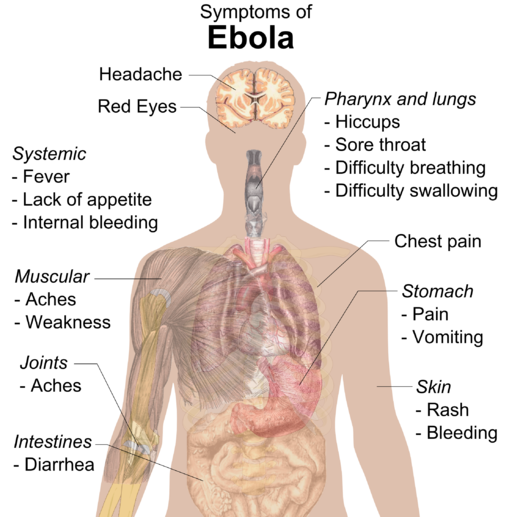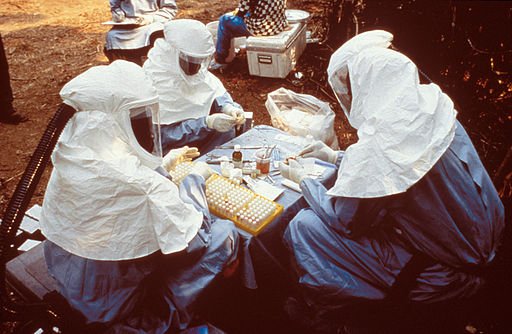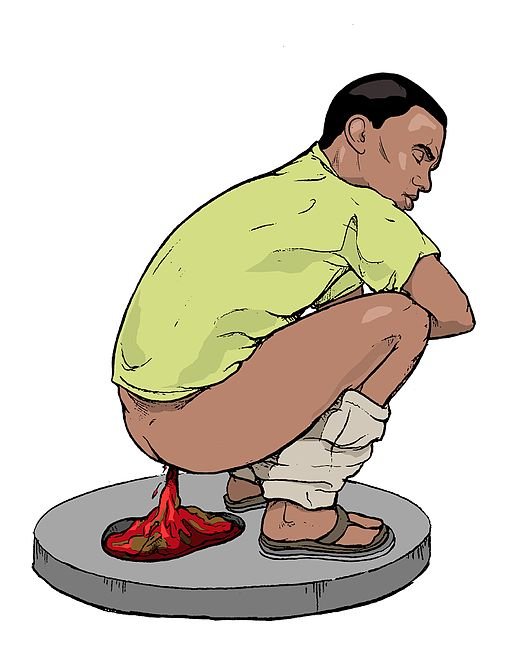Introduction
Hello Steemians, I feel excited to be here again. This time, we would be talking about one of the world's most deadly viral infections, one that kills people within a very short period of time, one that causes such a very horrible and painful death, in which case the infected individuals bleed out severely from different parts of their body, such as their nose, mouth, and even from their eyes.
It feels so sad to imagine a human being bleeding out to death in such a terrifying way. We are going to be talking about a disease that is so contagious that any contact with any body fluid or secretions from infected individuals would lead to the transmission of this infection. Most of us, if not all of us, must have heard of the March 2014 outbreak of this disease in Africa, which was not quickly recognized, as a result, some of the infected people in Africa, traveled to other parts of the world, thereby spreading this disease to other countries outside Africa. This March 2014 outbreak was termed the "Unprecedented epidemic". It led to the death of more than eleven thousand (11,000) human beings.
This epidemic was so bad that in trying to treat infected patients, so many doctors, nurses, and other medical professionals lost their lives in the process. I'm talking about the lethal disease called Ebola hemorrhagic fever, commonly known as the Ebola virus disease.
.jpg)
Wikimedia Commons: Ebola virus
What exactly is Ebola hemorrhagic fever?
Ebola hemorrhagic fever is caused by a virus called Ebola virus. The symptoms are nonspecific. This disease causes internal and external bleeding. Ebola hemorrhagic fever is regarded as one of the world's most lethal viral infections; the death rate is really very high. It ranges between 50% -100%. That is, if 10 people get infected with Ebola virus disease, 5-10 of these people would die of this disease.
Most of the outbreaks occur in regions or areas where medical facilities, high level supportive services are lacking or inadequate. Hence, it is actually very difficult to know the real survival rate since this disease does not break out in areas with high level medical facilities and resources to handle it effectively.
The history of Ebola hemorrhagic fever
Ebola hemorrhagic fever occurred for the first time in Zaire, which is now called the Democratic Republic of Congo (DRC) in 1976. The first outbreak occurred in a village that was very close to the Ebola River; as a result, the disease was named after the Ebola River. 318 patients were diagnosed of Ebola, out of them 88% died. Ever since then, Ebola virus breaks out in that region from time to time.
It has been identified that there are five strains of this virus. Out of which four of the strains lead to high death rates. These four strains include- Zaire, Sudan, Tai Forest, and Bundibugyo virus. Zaire Ebolavirus has been found to be the most deadly strain. The last strain which is found in the Phillipines is called Reston. The Reston Ebolavirus infects pigs, primates and in some cases humans. It causes only few or no symptoms, and there has been no deaths in humans.
The most dangerous and lethal strains of the Ebola virus have been found to occur in Africa, specifically in West Africa and chiefly in small villages and towns. The life cycle of this virus is maintained in the wild in animals such as monkeys, bats etc. Humans can be infected by eating or handling infected animals. In Africa, once an outbreak is recognized the whole area is isolated by officials until the outbreak is contained.
In March 2014, the last outbreak began in West Africa. Unfortunately, before the outbreak was recognized, Ebola infected people had already reached major cities. This led to even further spread of the disease. It was detected that the Ebola virus that broke out at that time was the Zaire strains; which as I mentioned above is the most lethal strain of Ebola. This outbreak was termed the "Unprecedented epidemic" by health agencies. This epidemic spread to Sierra Leone, Guinea, Liberia, Uganda, Sudan etc. It was also noted that a few infections occurred in Spain, the United States, and the United kingdom. Most of the infected people in these countries were found to have been infected originally in West Africa.
Is Ebola virus disease contagious?
It is very contagious. So long as early symptoms develop such as fever, then it is highly contagious. All body fluids or secretions become infected with this virus in infected patients. Any form of direct contact with any of these body secretions may cause the transmission of this virus to uninfected people. Centers for Disease Control and Prevention (CDC) suggests that Ebola virus can possibly be airborne but it is uncertain.
Causes
Ebola hemorrhagic fever is caused by Ebola virus infection. This results in abnormal coagulation, gastrointestinal bleeding, rash development, release of cytokine, liver damage, massive viremia; which means huge number of viruses in the blood. Massive viremia may lead to vascular cells damage. As this continues, microvascular endothelial cells are destroyed, which may lead to internal and external bleeding- bleeeding from the nasal passages, mouth, eyes, gums etc. As a result of this apparently uncontrolled bleeding, blood and body fluid loss causes shock which then causes death in many of the Ebola virus infected patients.
Risk factors
The risk factors for Ebola infections are travelling to regions where Ebola virus infections have been found to occur. If you want to travel, make sure you see the recent CDC travel advisories for movement to and within African countries. Also important to note is that associating with animals, most especially primates in regions where this infections have been reported is very risky to your health.
Eating or touching bush meat is also a potential source of Ebola virus. Bush meat includes meat from wild animals such as primates, hoofed animals, rodents, and bats etc. There are no evidence of any airborne transmission of Ebola virus. Take note, health care workers, friends and family members that are associated with the infected person are at very great risk of having this infection. It has also been found that researchers who study this disease are at high risk of getting this infection; this may occur if there's laboratory accident.
Attending to people infected with Ebola virus who are near-death or those who dispose the bodies of people that died of Ebola virus is a high risk factor; this is due to the fact that Ebola infection is highly concentrated in the blood and secretions of the body. It is recommended that caregivers wear appropriate protective equipment.
Signs and Symptoms
Ebola virus infection is nonspecific at the early stages. The symptoms may include- weakness, fever, vomiting, headaches, diarrhoea, reduced appetite, stomach discomfort, muscle and joint discomfort. As Ebola virus infection progresses, the patients may develop some signs and symptoms which may include- hiccups, rash, sore throat, eye redness, cough, mental confusion, chest pain, bleed internally and externally, breathing difficulty.

Wikimedia Commons: Symptoms of Ebola
Health care professionals that treat Ebola virus
Ebola virus is highly contagious. Health care workers can be infected easily by patients, hence the CDC and other agencies recommended that only well trained people treat Ebola infected patients. The treatment involves techniques to protect health care workers such as the doctors, nurses, janitors, laboratory technician etc.
Sadly, high-level professionals or health care workers and resources are not present in areas with high Ebola risk. Here are some of the specialist who may treat people infected with Ebola virus- infectious disease specialists, pulmonologist, hospitalists, hematologists, critical care doctors and nurses etc.
Contagious period for Ebola Infection
Patients who make it or survive Ebola virus disease may still be contagious for up to 21-42 days after the symptoms diminish or disappears. Although, it is not confirmed, according to CDC, Ebola virus disease can still be recovered from the breast milk, ocular fluid, semen and spinal column. Hence, the CDC suggest that male survivors of the infection should abstain from sex or ensure that they use a condom for all sexual activities.
Incubation period for Ebola virus disease
Signs and symptoms of Ebola virus may appear from 2-21 days after infection. On the average, the incubation period is between 8 and 10 days. It is still unknown why some people can survive and others die from this infection. Although, it has been found that people who die of Ebola virus usually have a deficient immune response to the infection. Individuals who survive Ebola infection usually have chronic problems which may include eye problems and fatigue.

Wikimedia Commons: Ebola Outbreak
Diagnosis
Ebola virus disease is diagnosed primarily by association with other people with Ebola infection and with the symptoms that were described above. After the symptoms develop, ELISA, virus isolation and PCR test would be able to provide a definite diagnosis. Also, for epidemiological purposes, studies using PCR, immunohistochemistry testing and virus isolation are done on dead Ebola infected patients.
Treatment for Ebola virus disease
The CDC has no exact or specific treatment for Ebola hemorrhagic fever. Though, the CDC recommends that Ebola infected patients should be treated as follows- maintaining blood pressure and oxygen level, balancing electrolytes, that is, balancing the body salts and treating other diseases if they occur.
In U.S. patients diagnosed with Ebola hemorrhagic fever are immediately sent to hospitals that are certified to treat Ebola infected patients. These hospitals were certified because of the unfortunate experience in a hospital in Texas, where the very first Ebola patient in U.S. was diagnosed and afterwards, the disease spread to hospital workers. There are some experimental medical treatments for Ebola virus disease and these include- antiviral drugs, blood transfusion, immune serum and intensive care supportive hospital facility.
Complications
The complications of Ebola hemorrhagic fever may include jaundice, severe bleeding, organ failures, seizures, shock, coma and the death of about 50%-100% of infected patients. Patients who survive Ebola virus disease may still have complications that may take so many months. The survivors of this infection experience headaches, fatigues, hepatitis, hair loss, inflammation of organs, sensory changes etc. Ebola virus may still be present in the semen for several months and may also be latent in the eyes. As a result, male survivors are recommended to utilize condoms for at least six months after they survive the infection.

Wikimedia Commons: Symptoms of complicated Ebola infection- Bloody diarrhoea
Prognosis
Ebola hemorrhagic fever has a very poor prognosis. The mortality rate of this infection is high and ranges from 50%-100%, and the survivors may experience the complications above mentioned. Early diagnosis and medical treatment of Ebola virus disease may greatly increase the patient's survival chances.
It is really sad that this disease has been chiefly located in countries where high level medical care is often lacking or inadequate. This disease often breaks out in rural areas in Africa. Statistics that are available on 2014-2015 outbreak suggest that about 11,310 people died in that outbreak.
Prevention
The major way to prevent getting Ebola virus disease is to not travel to regions where it is endemic and making sure to stay away from people who may have the infection. Health care professionals should protect themselves by obeying strictly to barriers of the virus such as wearing gowns, goggles, gloves and mask.
In 2016, precisely in December, researchers reported an effective and safe vaccination against Ebola virus disease. The vaccine is called rVSV-ZEBROV. Many of the vaccinated people showed side effects such as mild headaches, fatigue, pain, muscle, muscle pain etc. The good news was that majority of the individuals recovered within a few days; and none of these individuals developed long-term problems. This vaccine was regarded by many researchers and investigators to be an effective and safe vaccine. A reserve of about 300,000 doses of this vaccine is stored for future outbreaks.
Conclusion
Ebola hemorrhagic fever has very poor survival rate. Therefore, it is safer not to get infected than to seek for cure. Better safe than sorry. Therefore I strongly suggest that you should carry out thorough investigation of places you intend travelling to; so that you don't go to areas that have a high risk of Ebola virus disease outbreak.
As I mentioned above, the major places where Ebola outbreaks have occurred are in Africa. Hence, when travelling to Africa from other continents or if you live in Africa, when travelling within African countries, be very careful. I also suggest that if you notice signs and symptoms similar to those of Ebola virus disease, better seek immediate medical attention. The sooner the detection of this disease, the higher the chances of survival.
Also, medical professionals should ensure that they protect themselves very well from this lethal virus by wearing gowns, goggles, gloves and mask when attending to Ebola infected patients.
Thanks for reading!
References
Image Sources
All images used here are from free sources and liable for commercial use
all licensed under the Creative Commons.

)
)
)
.jpg](https://cdn.steemitimages.com/DQmVskKUGD6VqPchd6oEnFHNCySbMes3MRXJxqNm6eUjjih/Practising_taking_blood_in_Ebola_saftey_suits_(15649429018).jpg))
Hello @starrichie,
Air-Clinic sends her greeting! We are happy that you are creating amazing medical contents on Steemit using the #Air-Clinic tag.
This article was found as a result of #Air-Curie Initiative!We encourage you to keep it up!
Expect an upvote from @Air-Clinic soon!
If you haven't joined us on Discord please do so by clicking here
Cheers!
Dr. Qamran Bashir- Air-Clinic Curator!
Downvoting a post can decrease pending rewards and make it less visible. Common reasons:
Submit
Congrats @starrichie
Your great article has been selected to feature in this week Air-Curation Round 14.
Expect an upvote from a supporter of this initiative.
Continue using the #Air-Cliniic tag.
Downvoting a post can decrease pending rewards and make it less visible. Common reasons:
Submit
Very interesting and useful post. Everyone needs to know about Ebola. Thank you. Good work!
Downvoting a post can decrease pending rewards and make it less visible. Common reasons:
Submit
Thanks a lot @biologist
Downvoting a post can decrease pending rewards and make it less visible. Common reasons:
Submit
Interesting article. I only got to know much about Ebola when it almost find it's way into Nigeria. At the moment, is there is an epidermic of this disease in any country? I actually hope it is not.
When you talk about wild animals, are you generalizing all or some specific ones?
Downvoting a post can decrease pending rewards and make it less visible. Common reasons:
Submit
Generally, it's safer to avoid all bush meat or animals. But specifically, it's been found out that animals like bat, rodents and primates carry this virus in the wild. Thanks for your comment!
Downvoting a post can decrease pending rewards and make it less visible. Common reasons:
Submit
Thanks for the clarification
Downvoting a post can decrease pending rewards and make it less visible. Common reasons:
Submit
What a very interesting post on ebola virus. A haemorrhagic disease. Let just endeavour to protect ourselves from the disease by avoiding bush meat as much as possible. Thanks wonderful post...@starrichie
Downvoting a post can decrease pending rewards and make it less visible. Common reasons:
Submit
Thanks a bunch @tundevet
Downvoting a post can decrease pending rewards and make it less visible. Common reasons:
Submit
Nice walk-through you did here bro. Deadly is an understatement when describing this disease. The outbreak in Nigeria created a big scene.
Thanks for this enlightening post. Keep writing
Downvoting a post can decrease pending rewards and make it less visible. Common reasons:
Submit
Thanks a lot @mrbreeziewrites.
Downvoting a post can decrease pending rewards and make it less visible. Common reasons:
Submit